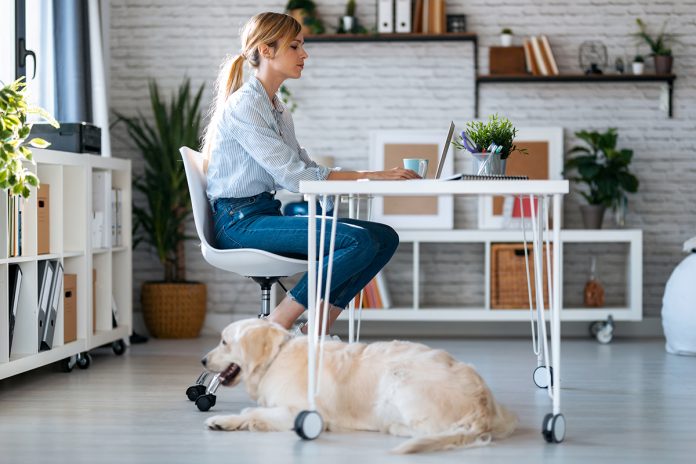Fintan Burke and Alison White of independent workplace designers, PLACEmaking, explore how organisations can meet the demand for workplace change post-COVID
As we emerge from the COVID disruption, traditional assumptions of how, when and where we work are being reappraised. No matter the political pressure to reoccupy those city centre office buildings, many organisations recognise this as the moment to evaluate their future needs and respond to a tidal wave of demand for workplace change.
One consistent theme in staff surveys is the demand for more flexibility, limiting unnecessary daily commuting into a city or town centre offices, accelerating over a decade of demand for workplace change. Even if some employers are slow to recognise that a new order is needed, what must be asked is what will the office of the future look like?
The Digital HQ
The pandemic had the effect of bringing a new perspective on how organisations view their HQs. With many organisations reporting productivity being maintained and often enhanced despite people not being corralled in to a building everyday, then the justification for high building rents and eye watering operational running costs becomes somewhat problematic. Few leadership teams are blind to these issues, many are looking for solutions that reflect a growing demand for adaptability and flexibility.
Five or more years from now, 2020 may well be viewed as a watershed moment in working world history not just because of the dramatic embracing of hybrid working, but because the lockdown experience challenged so many established assumptions about what it is to live and work in this modern world.
Looking forward we could well see the end to organisations owning or occupying singular spaces. Without the need for permanent, fixed spaces HQ’s could exist digitally rather than physically with many enterprises not needing to lease or own a building at all, clearly not great news for those that simply assumed things would go back to the pre March 2020 ‘old’ normal, yet, for those that did recognise the significance of the 2020 shift, new and different opportunities are evident.
The scale of change we are now faced with is inevitably uncomfortable for many, not least the supply chain businesses dependant on the previously reliable daily commuter workforce. Could they though with creative thinking, be the enablers and facilitators the workplaces fit for the future?

Changing needs
From March 2020 onwards, huge numbers of people have integrated flexibility in their daily work patterns. It seems inevitable that after such a period of sustained, dramatic changes to the way we work would have an ongoing and permanent impact. Suddenly, irrespective of rank or role everyone who could was instructed to work from home and, as a consequence they all had to adapt almost overnight, rapidly embrace new technologies, methods of communications and take on levels of personal responsibility that had often had been previously denied to them.
Some people have struggled during this period but many have thrived in their now well established work patterns. As a result some are simply wanting to work from home more regularly but for others the experience has amplified the profound question – why would we compromise what we’ve gained and go back to the working patterns formed in the distant past when we have the ability, the technology and the desire to do things differently?
The pandemic has proved to their employers and often themselves that even the most technophobe amongst us can adapt and use remote access systems without significant detrimental impact on traditional measurements of productivity. It has also demonstrated that better work-life balance, less commute times, more choice about where we live and work, and more time with our families are no longer the experience for the lucky few, but instead a new status quo for the working world. It’s time that the workplaces is modernised to match this momentum.
So if the days of daily commuting to a city just to sit at a computer all day are being rejected by so many what will our future way of working look like and who’s going to make this happen? In short, there’s a role for everyone: employers and employees, service providers and landlords/developers.
Where we work
Just as the traditional attitudes towards the HQ are beginning to seem outdated so too will the notion of a spending every day with the same people because we happen to work for the same employer. One result from the lockdowns is that we know we can be part of a global digital community and be physically based in our local community. At the same time working at home is not the single alternative to going to the office every day and so we’ll see growth in co-working hub options, especially if located within easy walking or cycling distance from home.
These hubs are not offices, they shouldn’t look or operate like an office and any suggestion of establishing a level of control on the users will be a complete turn-off. There is an opportunity for a complete new culture of characterful, quirky and inclusive options that are presented in response to the bespoke expectations whether by generational needs or personal tastes.
So we’ll be happy to share use of our local hub with others from different businesses, organisations and enterprises and we’ll look to higher levels of partnering, sharing of initiatives, opportunities and resources.
From our local hub, we’ll be selective about physically travelling to the HQ office. The purpose and experience of going there will need to be positive with employers needing to create events that attract us, focusing on hosting networking, knowledge exchange and skills development activities. The experience from such events will need to be high quality including the invitation, the booking process, the journey, the value we get from time spent in activities once there and the post-visit perception of the beneficial connections made and how they can be nurtured.
As we emerge from the restrictions of the COVID-19 pandemic there will inevitably be questions of how we move forward. One thing that is clear, the traditional ‘way of doing things’ is no longer fit for purpose. The workplace of the future may not even be a ‘place’ at all, but instead a way of working built around flexibility, digital HQ’s, locally-based co-working hubs and personal spaces in the home.
Please note: This is a commercial profile











